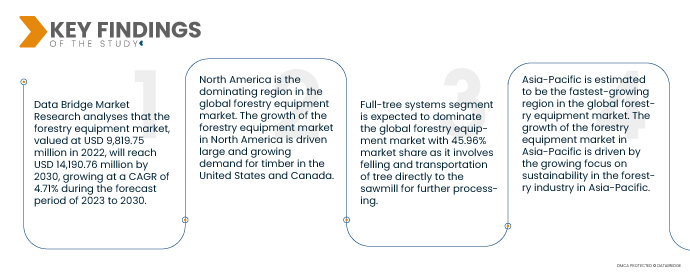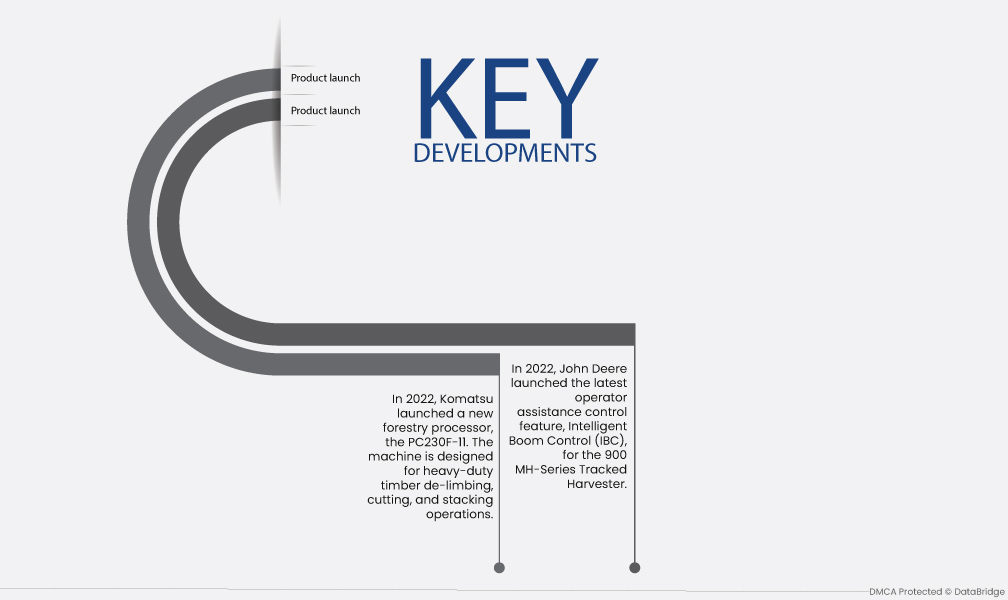In 2019, falling equipment led the market, accounting for more than 36% of global revenue. The portion includes tools such as a chainsaw, feller buncher, and harvester. Feller bunchers are expected to be the fastest-growing sub-segment due to increased safety and higher output compared to chainsaws. The market is divided into four categories according on product type: felling, extraction, on-site, and other equipment. The growing number of contracts between product makers and end-users is expected to create chances for industry participants, boosting the global market.
Access Full Report @ https://www.databridgemarketresearch.com/reports/global-forestry-equipment-market
Data Bridge Market Research analyses that the Forestry Equipment Market, valued at USD 9,819.75 million in 2022, will reach USD 14,190.76 million by 2030, growing at a CAGR of 4.71% during the forecast period of 2023 to 2030. The expanding emphasis on forest management activities, together with increased investment in the forestry sector, is expected to boost product demand over the projection period. Various government afforestation strategies are resulting in product uptake for the thinning process, which promotes forest health while promoting environmental sustainability. As people become more conscious of the need of forest preservation and management, demand for forestry equipment such as forwarders, harvesters, and loaders is expected to rise.
Growing demand for timber is expected to drive the market's growth rate
The global demand for timber is growing, due to the increasing demand for wood products in construction, furniture, and other industries. This is driving the demand for forestry equipment, as it is used to harvest timber from forests. There is a growing focus on sustainability in the forestry industry, as businesses and governments are looking for ways to reduce the environmental impact of forestry operations. This is driving the demand for forestry equipment that is more efficient and environmentally friendly. Technological advancements, such as the use of GPS and remote sensing, are making forestry equipment more efficient and accurate. This is driving the demand for forestry equipment, as businesses look for ways to improve their productivity.
Report Scope and Market Segmentation
Report Metric
|
Details
|
Forecast Period
|
2023 to 2030
|
Base Year
|
2022
|
Historic Years
|
2021 (Customizable to 2015- 2020)
|
Quantitative Units
|
Revenue in USD Million, Volumes in Units, Pricing in USD
|
Segments Covered
|
유형(벌목 장비, 추출 장비, 현장 가공 장비, 절단 및 적재 장비 및 기타 장비), 제품(가지치기 기계, 벌목기, 그루터기 분쇄기, 멀처, 야드, 포워더, 통나무 로더, 수확기, 스키더, 목재 운송 트럭, 에너지용 파쇄기-목재 및 기타), 전원(가솔린, 배터리, 전기 코드식, 무선식 및 기타), 재료(금속, 플라스틱, 목재, 재활용 플라스틱, 합성 수지 및 기타), 산림 유형(천연, 인공, 수목 조림), 시스템 유형(전체 수목 시스템, 짧은 수목 시스템 및 수목 길이 시스템), 기술(수목 벌채, 가지 치기 및 가지 제거, 껍질 제거, 추출, 통나무 만들기/교차 절단, 스케일링, 분류 및 쌓기, 적재 및 기타), 유통 채널(제3자 유통업체, B2B/직판, 전자 상거래, 브랜드 웹사이트, 전문 매장 및 기타)
|
포함 국가
|
미국, 캐나다 및 멕시코(북미), 독일, 프랑스, 영국, 네덜란드, 스위스, 벨기에, 러시아, 이탈리아, 스페인, 터키, 유럽의 기타 유럽 국가, 중국, 일본, 인도, 한국, 싱가포르, 말레이시아, 호주, 태국, 인도네시아, 필리핀, 아시아 태평양(APAC)의 기타 아시아 태평양 국가(APAC), 사우디 아라비아, UAE, 남아프리카 공화국, 이집트, 이스라엘, 중동 및 아프리카(MEA)의 일부인 기타 중동 및 아프리카(MEA), 브라질, 아르헨티나 및 남미의 일부인 기타 남미
|
시장 참여자 포함
|
Konrad Forsttechnik GmbH(독일), Komatsu Forest(스웨덴), HSM Hohenloher Spezial-Maschinenbau GmbH & Co. KG(독일), SP Maskiner(스웨덴), Log Max AB(스웨덴), FTG Cranes AB(스웨덴), CRANAB AB(스웨덴), Penz Crane GmbH(독일), Quadco Inc.(캐나다), Southstar Equipment(캐나다), 로토벡(캐나다)
|
보고서에서 다루는 데이터 포인트
|
Data Bridge Market Research에서 큐레이팅한 시장 보고서에는 시장 가치, 성장률, 세분화, 지리적 범위 및 주요 업체와 같은 시장 시나리오에 대한 통찰력 외에도 심층적인 전문가 분석, 지리적으로 대표되는 회사별 생산 및 용량, 유통업체 및 파트너의 네트워크 레이아웃, 상세하고 업데이트된 가격 추세 분석 및 공급망 및 수요의 적자 분석이 포함됩니다.
|
세그먼트 분석:
글로벌 임업 장비 시장은 유형, 제품, 전원, 재료, 산림 유형, 시스템 유형, 기술 및 유통 채널을 기준으로 8개의 주요 부문으로 구분됩니다.
- 유형별로 보면, 세계 임업 장비 시장은 벌목 장비, 채굴 장비, 현장 가공 장비, 절단 및 적재 장비, 그리고 기타 장비로 구분됩니다. 벌목 장비 부문은 목재, 소나무 등의 벌목에 사용되며, 심지어 벌목의 첫 번째 공정으로 여겨지기 때문에 36.77%의 시장 점유율을 기록하며 세계 임업 장비 시장을 주도할 것으로 예상됩니다.
- 제품 기준으로 세계 임업 장비 시장은 가지치기 기계, 벌목기, 그루터기 분쇄기, 멀처, 야더, 포워더, 원목 적재기, 수확기, 스키더, 목재 운반 트럭, 에너지 목재용 파쇄기 등으로 세분화되었습니다. 수확기 부문은 자체 추진 방식으로 나무를 벌목하고 가공할 수 있어 작업자의 벌목을 용이하게 하는 제품 수요 증가에 힘입어 28.17%의 시장 점유율을 기록하며 세계 임업 장비 시장을 주도할 것으로 예상됩니다.
- 동력원을 기준으로 세계 임업 장비 시장은 휘발유, 유선, 배터리, 무선 등으로 구분됩니다. 휘발유는 세계 임업 장비 시장의 50.70%를 차지하며 시장을 주도할 것으로 예상되는데, 이는 대부분의 장비에 임업에서 벌목 작업에 필요한 동력을 제공하는 가솔린 엔진이 장착되어 있기 때문입니다.
- 재료 기준으로 세계 임업 장비 시장은 목재, 금속, 플라스틱, 재활용 플라스틱, 합성수지 등으로 세분화되었습니다. 금속 부문은 68.30%의 시장 점유율로 세계 임업 장비 시장을 주도할 것으로 예상됩니다. 금속은 산림에서 장비 작동 시 강도, 안정성, 신뢰성을 높여주므로 헤드, 커터, 크레인, 버킷과 같은 제품이 금속을 사용하여 제조되고 있습니다.
- 산림 유형을 기준으로 세계 임업 장비 시장은 천연림, 인공림, 그리고 조림지로 구분됩니다. 인공림은 수출용 목재 및 소나무 벌목에 주로 사용되기 때문에 세계 임업 장비 시장에서 45.82%의 시장 점유율을 차지할 것으로 예상됩니다. 또한, 목재 산업 발전을 위해 토지가 인공림으로 전환되는 사례도 증가하고 있습니다.
- 시스템 유형을 기준으로 전 세계 임업 장비 시장은 전나무 시스템, 단목 시스템, 그리고 전나무 길이 시스템으로 구분됩니다. 전나무 시스템 부문은 벌목 후 제재소로 직접 운반하여 추가 가공하는 방식으로 시간과 에너지를 절약하고 많은 기업들이 도입하고 있어 시장 점유율 45.96%를 기록하며 전 세계 임업 장비 시장을 주도할 것으로 예상됩니다.
- 기술 기준으로 세계 임업 장비 시장은 벌목, 전정 및 가지 제거, 수피 제거, 추출, 원목 제작/횡단, 스케일링, 선별 및 적재, 적재 등으로 세분화됩니다. 전정 분야는 나무껍질을 절단하여 전정 및 가지 제거와 같은 후속 작업을 용이하게 하는 기술로, 33.60%의 시장 점유율을 기록하며 세계 임업 장비 시장을 주도할 것으로 예상됩니다.
껍질 제거 부문은 임업 장비 시장의 기술 부문을 지배할 것입니다.
박피 부문은 기술 부문에서 가장 큰 비중을 차지하는 분야로 부상할 것입니다. 특히 개발도상국 시장에서 박피 장비의 가용성이 증가하고 있기 때문입니다. 또한, 전 세계적으로 연구 개발 서비스가 성장하고 확대됨에 따라 이 부문의 성장은 더욱 가속화될 것입니다.
- 유통 채널을 기준으로 글로벌 임업 장비 시장은 B2B/직판, 제3자 유통업체, 전자상거래, 전문 매장, 브랜드 웹사이트 등으로 세분화되었습니다. B2B/직판 부문은 50.63%의 시장 점유율로 글로벌 임업 장비 시장을 주도할 것으로 예상됩니다. 이는 기업들이 이 유통 채널을 통해 고객에게 제품을 손쉽게 판매하고 고객 기반을 극대화하는 데 널리 활용하고 있기 때문입니다.
B2B/직접 판매 부문은 임업 장비 시장의 유통 채널 부문을 지배할 것입니다.
B2B/직판 부문은 유통 채널에서 가장 큰 비중을 차지하는 부문으로 부상할 것입니다. 이는 특히 개발도상국 시장에서 인프라 개발 활동이 증가하고 있기 때문입니다. 또한, 전 세계적으로 화학 및 소재 산업의 성장과 확장은 이 부문의 성장을 더욱 가속화할 것입니다.
주요 플레이어
Data Bridge Market Research에서는 다음 회사를 주요 시장 주체로 인식합니다: Konrad Forsttechnik GmbH(독일), Komatsu Forest(스웨덴), HSM Hohenloher Spezial-Maschinenbau GmbH & Co. KG(독일), SP Maskiner(스웨덴), Log Max AB(스웨덴), FTG Cranes AB(스웨덴), CRANAB AB(스웨덴), Penz crane GmbH(독일), Quadco Inc.(캐나다), Southstar Equipment(캐나다), Rotobec(캐나다).
시장 개발
- 2022년, 코마츠는 새로운 임업용 가공기 PC230F-11을 출시했습니다. 이 기계는 고하중 목재 가지치기, 벌목, 적재 작업에 적합하도록 설계되었습니다. 강력한 스윙 시스템과 대형 나무를 더욱 쉽게 옮길 수 있는 대형 원통형 휠을 갖추고 있습니다. PC230F-11은 이전 모델보다 연비가 향상된 197마력의 코마츠 티어 4 파이널 엔진을 탑재했습니다. 또한, 연료 탱크를 카운터웨이트로 옮겨 연료 용량을 두 배로 늘렸습니다. 덕분에 공구, 오일, 체인 등을 보관할 수 있는 공간이 더욱 넓어졌습니다.
- 2022년, 존 디어는 900 MH 시리즈 트랙형 수확기에 최신 운전자 지원 제어 기능인 지능형 붐 제어(IBC)를 출시했습니다. IBC는 작업 현장에서 일관되고 원활한 작동을 제공하여 직관적인 운전자 지원을 제공합니다. 이는 존 디어 휠드 컷투렝스(Wheeled Cut-to-Length) 팀과 풀트리 임업(Full-Tree Forestry) 팀의 글로벌 협력을 통해 탄생했으며, 현장에서 검증된 IBC 기술을 MH 시리즈 트랙형 수확기에 적용하고자 했습니다.
지역 분석
지리적으로 시장 보고서에서 다루는 국가는 북미의 미국, 캐나다 및 멕시코, 유럽의 독일, 프랑스, 영국, 네덜란드, 스위스, 벨기에, 러시아, 이탈리아, 스페인, 터키, 유럽의 기타 유럽, 중국, 일본, 인도, 한국, 싱가포르, 말레이시아, 호주, 태국, 인도네시아, 필리핀, 아시아 태평양(APAC)의 기타 아시아 태평양(APAC), 사우디 아라비아, UAE, 남아프리카 공화국, 이집트, 이스라엘, 중동 및 아프리카(MEA)의 일부인 기타 중동 및 아프리카(MEA), 남미의 일부인 기타 남미입니다.
Data Bridge Market Research 분석에 따르면:
북미는 2023-2030년 예측 기간 동안 임업 장비 시장에서 지배적인 지역입니다.
북미는 세계 임업 장비 시장을 주도하는 지역입니다. 북미 임업 장비 시장의 성장은 미국과 캐나다의 목재 수요 급증과 북미 임업 장비 기술의 발전에 힘입은 것입니다.
아시아 태평양 지역은 2023-2030년 예측 기간 동안 임업 장비 시장 에서 가장 빠르게 성장하는 지역으로 추산됩니다 .
아시아 태평양 지역은 세계 임업 장비 시장에서 가장 빠르게 성장하는 지역으로 추정됩니다. 아시아 태평양 지역 임업 장비 시장의 성장은 중국과 인도의 목재 수요 증가와 아시아 태평양 지역 임업 산업의 지속가능성에 대한 관심 증가에 힘입어 가속화되고 있습니다.
임업 장비 시장 보고서에 대한 자세한 내용은 여기를 클릭하세요 - https://www.databridgemarketresearch.com/reports/global-forestry-equipment-market












